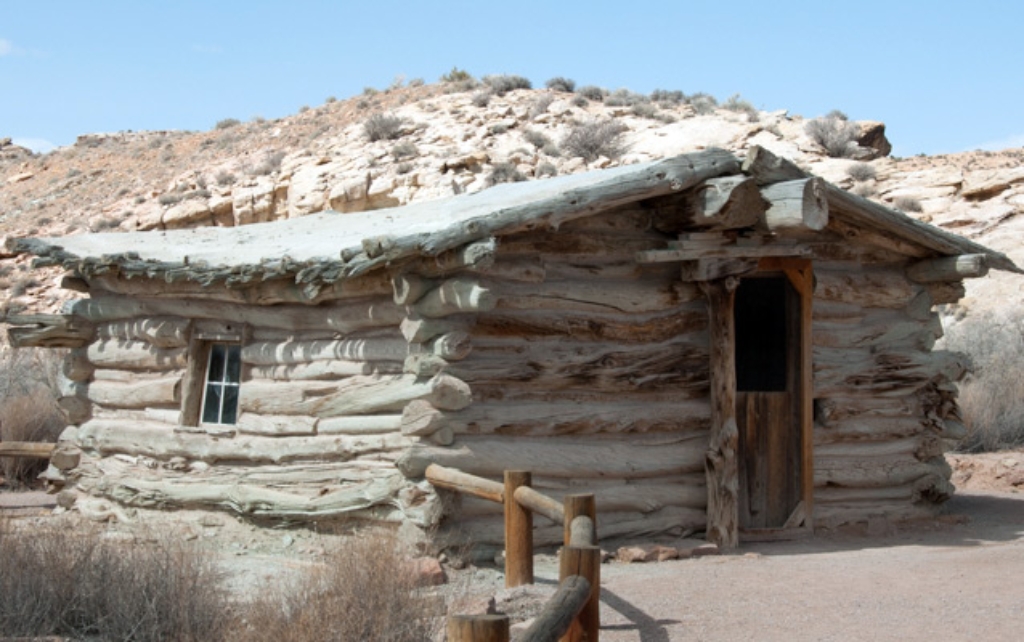
This humble, one-room cabin sits near the present-day trailhead for the hike to Delicate Arch. Visitors regularly peer through the doorway and wonder aloud, "Who lived here... and how?... And why?"
Starting Over
In 1898, a nagging leg injury from the Civil War prompted 69-year-old John Wesley Wolfe to leave his wife and three of his children in Etna, Ohio, and seek a drier climate. He brought his oldest son, Fred, with him, and the two settled a 100+-acre property along Salt Wash, just north of the village of Moab and close to a fresh water spring. For nearly a decade, they lived and worked alone on the remote "Bar DX" ranch, eventually grazing more than 1,000 head of cattle on native grasses that once covered this area.
Making a Home
The first cabin that John and Fred built was not elaborate, but provided basic shelter from spring winds, summer heat, fall rains, and winter cold. A dam on Salt Wash (no longer visible) captured water for root vegetables, pumpkins, and melons raised in their garden. They ordered staple groceries from the Sears, Roebuck & Co. catalog about once every three months and picked them up at the Thompson Springs railroad station, which was a full day’s wagon trip away.
The scene changed in 1906 when John's daughter, Flora, made the westward trek with her husband, Ed Stanley, and two young children, Esther and Ferol. Appalled by the condition in which her father and brother lived, Flora demanded they build a new cabin with a wooden floor and real windows. John obliged, creating the sturdy cabin that remains in the park to this day. All six family members lived and slept in the one-room cabin, measuring just 17 feet by 15 feet (5.2 m by 4.6 m). John Wolfe also constructed a root celler, irrigation dams, and a corral.
Traditions of Survival
People survived here long before the Wolfes. For centuries, people from Zuni, Hopi, Ute, Paiute, and many other American Indian tribes traveled through and camped in these landscapes. Even if they didn’t live here year-round, they knew of its many resources—most importantly, water. They hunted wild game, like bighorn sheep, on horseback, and some of them pecked images into the rock walls. They also gathered plants that are edible, medicinal, or can be used to make dye. A sparkly rock called selenite (visible from the park road near the cabin) and the blue-green Mancos Shale can be made into paint for ceremonies, and the hard white rock called chert (visible further down the trail to Delicate Arch) makes sharp-edged stone tools. Utes camped nearby during John Wolfe's stay here and traded their handmade blankets for garden produce and meat.
Flora spent two lonely years at the ranch. Wolfe tried to make her more comfortable in what must have seemed a desolate place. Because Flora disliked eating on tin plates, Wolfe ordered a one-hundred-piece set of blue china dishes from Sears. Wolfe also surprised his daughter with a camera and developing kit. Flora took a photograph of Delicate Arch, one of the earliest pictures taken of the now-famous feature.
In 1908, Flora and Ed moved to nearby Moab so the children could attend school. (That house also remains, a few blocks off Main Street in the center of town.) John and Fred Wolfe stayed at the ranch for two more years before joining them in Moab. John Wolfe and the Stanleys left Moab in 1910 and eventually moved back to Ohio where John died in 1913 at the age of 84.
After the Wolfes
Wolfe sold the ranch to Tommy Larson in 1910. Four years later, J. Marvin Turnbow, the first custodian of Arches National Monument, bought it. The Turnbows used the cabin sporadically until selling the ranch to Emmit Elizondo, who then sold the property to the US government for inclusion in Arches National Monument.
In 1975, Wolfe Ranch and surrounding acreage were listed on the National Register of Historic Places . The nomination reads: “Historically, the activities of man on the Colorado Plateau have been a function of his ability to exploit and control its meager water resources. Wolfe’s ranching operation on Salt Wash is an excellent example of early subsistence farming and grazing in a marginal environment."
It was indeed a marginal environment, and years of cattle and sheep grazing have had a significant impact on the natural vegetation of the region. No grazing has occurred for decades, but native grasses are still sparse and in some localized areas have disappeared completely. Today, we may admire the perseverance and determination of early ranchers, but we also realize that the impacts of their actions went far beyond their brief stay. It will be years—if ever—before the ranch and surrounding area look like they did when American Indians or John Wesley Wolfe first saw it.
Is there something we missed for this itinerary?
Itineraries across USA


















































